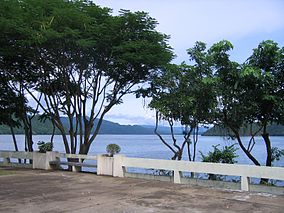Khuean Srinagarindra National Park
| Khuean Srinagarindra National Park | |
|---|---|
| อุทยานแห่งชาติเขื่อนศรีนครินทร์ | |
 Srinagarind Reservoir | |
| Location | Kanchanaburi Province, Thailand |
| Nearest city | Kanchanaburi |
| Coordinates | 14°44′39″N 99°2′10″E / 14.74417°N 99.03611°E |
| Area | 1,532 km2 (592 sq mi) |
| Established | December 1981 |
| Visitors | 145,254 (in 2019) |
| Governing body | Department of National Parks, Wildlife and Plant Conservation |
Khuean Srinagarindra National Park (Thai: อุทยานแห่งชาติเขื่อนศรีนครินทร์, RTGS: Utthayan Haeng Chat Khuean Si Nakharin, pronounced [ʔùt.tʰā.jāːn hɛ̀ŋ t͡ɕʰâːt kʰɯ̀a̯n sǐː ná(ʔ).kʰā.rīn]; "Srinagarind Dam National Park") is a national park in Kanchanaburi Province, Thailand. The park, centred on the Srinagarind Reservoir, is part of the Western Forest Complex protected area.
Geography
[edit]Khuean Srinagarindra National Park is 105 kilometres (65 mi) northwest of Kanchanaburi town in Sai Yok, Si Sawat and Thong Pha Phum districts. The park's area is 957,500 rai ~ 1,532 square kilometres (592 sq mi).[1] At the heart of the park is the Srinagarind Reservoir, a reservoir created by the damming of the Khwae Yai river by the Srinagarind Dam.[2]
History
[edit]The park's caves, particularly Tham Phra Prang, were used by Thai soldiers as a hiding place during the Thai – Burmese wars of the 18th century.[2]
Srinagarind Reservoir formed on completion of the Srinagarind Dam in 1980. On 23 December 1981, Khuean Srinagarindra was designated a national park.[3]
Attractions
[edit]Khuean Srinagarindra's most popular attraction is Huay Mae Khamin waterfall, a waterfall of seven levels which eventually flows to the Khwae Yai River. The waterfall's source is in the mountains in the east of the park. Other park waterfalls include Pha Sawan and Pha Tat.[2][3]
The park contains numerous cave systems. The 150 metres (490 ft) long Tham Sawan features prehistoric cave paintings. Tham Neramit is dome-like in appearance and features stalactites and stalagmites. Tham Phra Prang, also featuring stalactites and stalagmites, hosts a Buddha image inside. Other caves include Tham Nam Mut and Tham Phra Kho.[2][3]
Flora and fauna
[edit]
The park's mountain forests are evergreen and deciduous.[2] Tree species include Hopea ferrea, Pterocarpus macrocarpus, Afzelia xylocarpa, Dalbergia oliveri, Shorea obtusa, Xylia xylocarpa, Shorea siamensis, Schleichera oleosa, Lagerstroemia calyculata and Tetrameles nudiflora.[4] Park animals include Asian elephant, tiger, gaur, lar gibbon, Phayre's leaf monkey and sambar.[4] Bird life features species such as olive-backed sunbird, Oriental pied hornbill, red junglefowl, scaly-breasted munia, scarlet-backed flowerpecker and thick-billed green pigeon.[4] Freshwater fish species in the park include giant snakehead, ocellated featherback (Chitala ornata), greater brook carp (Tor tambroides), yellow mystus and transverse-bar barb.[4]
See also
[edit]References
[edit]- ^ "ข้อมูลพื้นที่อุทยานแห่งชาติ ที่ประกาศในราชกิจจานุบกษา 133 แห่ง" [National Park Area Information published in the 133 Government Gazettes]. Department of National Parks, Wildlife and Plant Conservation (in Thai). December 2020. Retrieved 1 November 2022, no 39
{{cite web}}: CS1 maint: postscript (link) - ^ a b c d e "Khuean Srinagarindra National Park". Department of National Parks (Thailand). Archived from the original on 22 May 2013. Retrieved 20 May 2013.
- ^ a b c "Sri Nakarin National Park". Tourism Authority of Thailand. Retrieved 20 May 2013.[permanent dead link]
- ^ a b c d "Khuean Srinagarindra National Park". National Parks in Thailand (PDF). Department of National Parks (Thailand). 2015. pp. 187–188. ISBN 978-6-1631-6240-3. Archived from the original (PDF) on 15 February 2017.

